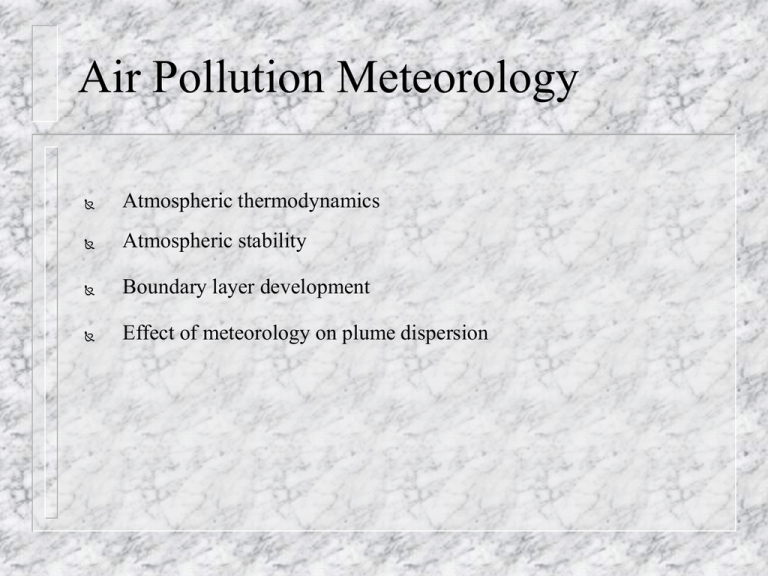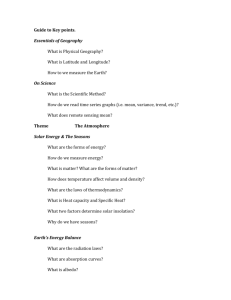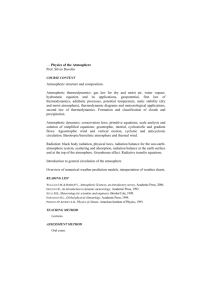Air Pollution Meteorology
advertisement

Air Pollution Meteorology Atmospheric thermodynamics Atmospheric stability Boundary layer development Effect of meteorology on plume dispersion Atmosphere Pollution cloud is interpreted by the chemical composition and physical characteristics of the atmosphere Concentration of gases in the atmosphere varies from trace levels to very high levels Four major layers of earth’s atmosphere are: Troposphere Stratosphere Mesosphere Thermosphere Atmospheric Thermodynamics A parcel of air is defined using the state variables Three important state variables are density, pressure and temperature The units and dimensions for the state variables are Density (mass/volume) gm/cm3 ML-3 Pressure (Force/Area) N/m2 ( Pa ) ML-1T-2 Temperature o F, o R, o C, o K T Humidity is the fourth important variable that gives the amount of water vapor present in a sample of moist air Equation of State Relationship between the three state variables may be written as: f ( P, ρ ,T) = 0 For a perfect gas: P = ρ .R .T R is Specific gas constant R for dry air = 0.287 Joules / gm /oK R for water vapor = 0.461 Joules / gm /oK R for wet air is not constant and depend on mixing ratio Laws of Thermodynamics First Law of Thermodynamics: This law is based on law of conservation of total energy. Heat added per unit mass = (Change in internal energy per unit mass) + (Work done by a unit mass) Second Law of Thermodynamics: This law can be stated as "no cyclic process exists having the transference of heat from a colder to hotter body as its sole effect" Specific Heat Defined as the amount of heat needed to change the temperature of unit mass by 1oK. Specific heat at constant volume Cv = lim δQ δT 0 δT Specific heat at constant pressure Cp = lim δQ δT 0 δT α = const p = const Relationship between Cv and Cp is given by Carnot’s law: For perfect gas, Cp – Cv = R For dry air Cp = (7/2). R Cv = (5/2). R Ratio of Cp and Cv for dry air is 1.4 Processes in the Atmosphere An air parcel follows several different paths when it moves from one point to another point in the atmosphere. These are: Isobaric change Isosteric change Isothermal change Isentropic change Adiabatic Process – – – – – constant pressure constant volume constant temperature constant entropy (E) δQ = 0 (no heat is added or removed ) The adiabatic law is P. αγ = constant E= Q T Statics of the Atmosphere Vertical variation of the parameters = ? Hydrostatic Equation: Pressure variation in a "motionless" atmosphere p .g z or 1 p g z Pressure variation in an atmosphere: 1 p d 2 z 2 z dt Relationship between pressure and elevation using gas law: 1 p g z Rd T Statics of the Atmosphere Integration of the above equation gives p g z 1 ln exp T . dz po Rd 0 Using the initial condition Z=0, P = P0 The above equation indicates that the variation of pressure depends on vertical profile of temperature. For iso-thermal atmosphere g 1 p exp To . z po Rd Therefore pressure decreases exponentially with height. 12.24 mb per 100m. Lapse Rate: Lapse rate is the rate of change of temperature with height Lapse rate is defined as Γ = -δT δz Value of Γ varies throughout the atmosphere Potential Temperature: Concept of potential temperature is useful in comparing two air parcels at same temperatures and different pressures θ = To = T 1000 P R/C p Atmospheric Stability The ability of the atmosphere to enhance or to resist atmospheric motions The stability depends on the ratio of suppression to generation of turbulence The stability at any given time will depend upon static stability ( related to change in temperature with height ), thermal turbulence ( caused by solar heating ), and mechanical turbulence (a function of wind speed and surface roughness). Atmospheric Stability Atmospheric stability can be determined using adiabatic lapse rate. Γ > Γd Unstable Γ = Γd Neutral Γ < Γd Stable Γ is environmental lapse rate Γd is adiabatic lapse rate (10c/100m) and dT/dZ = -10c /100 m Atmospheric Stability Classification Schemes to define the atmospheric stability are: P- G Method P-G / NWS Method The STAR Method BNL Scheme Sigma Phi Method Sigma Omega Method Modified Sigma Theta Method NRC Temperature Difference Method Wind Speed ratio (UR) Method Turbulence Fluctuations in wind flow which have a frequency of more than 2 cycles/ hr Types of Turbulence Mechanical Turbulence Convective Turbulence Boundary Layer Development Thermal boundary Layer (TBL) development depends on two factors: Convectively produced turbulence Mechanically produced turbulence Development of TBL can be predicted by two distinct approaches: Theoretical approach Experimental studies Theoretical approach may be classified into three groups: Empirical formulae Analytical solutions Numerical models One layer models Higher order closure models Effects of Meteorology on Plume Dispersion Dispersion of emission into atmosphere depends on various meteorological factors. Height of thermal boundary layer is one of the important factors responsible for high ground level concentrations At 9 AM pollutants are pulled to the ground by convective eddies Spread of plume is restricted in vertical due to thermal boundary height at this time Wind Velocity A power law profile is used to describe the variation of wind speed with height in the surface boundary layer U = U1 (Z/Z1)p Where U1 is the velocity at Z1 (usually 10 m) U is the velocity at height Z. The values of p are given in the following table. Stability Class Rural p Urban p Very Unstable 0.07 0.15 Neutral 0.15 0.25 Very Stable 0.55 0.30 Beaufort Scale This scale is helpful in getting an idea on the magnitude of wind speed from real life observations Atmospheric Wind speed Comments condition Calm < 1mph Smoke rises vertically Light breeze 5 mph Wind felt on face Gentle breeze 10 mph Leaves in constant motion Strong 25 mph Large branches in motion Violent storm 60 mph Wide spread damage Wind Rose Diagram (WRD) WRD provides the graphical summary of the frequency distribution of wind direction and wind speed over a period of time Steps to develop a wind rose diagram from hourly observations are: Analysis for wind direction Determination of frequency of wind in a given wind direction Analysis for mean wind speed Preparation of polar diagram Determination of Maximum Mixing Height Steps to determine the maximum mixing height for a day are: Plot the temperature profile, if needed Plot the maximum surface temperature for the day on the graph for morning temperature profile Draw dry adiabatic line from a point of maximum surface temperature to a point where it intersects the morning temperature profile Read the corresponding height above ground at the point of intersection obtained. This is the maximum mixing height for the day







